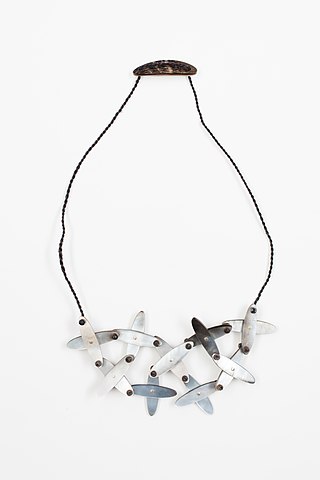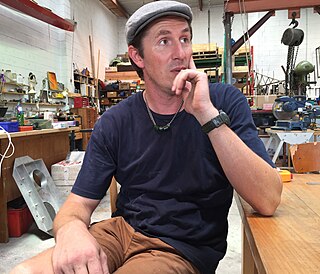Related Research Articles
Ann Verdcourt (1934–2022) was a New Zealand artist. She emigrated to New Zealand with her husband, ceramic artist John Lawrence, in 1965.
Jane Dodd is a New Zealand musician and contemporary jeweller. She is well known for her role as a bass player in early Dunedin-based Flying Nun Records groups The Chills and The Verlaines, was a long-standing member of Auckland group Able Tasmans, and occasionally played with side-project The Lure of Shoes.

Jens Høyer Hansen was a Danish-born jeweller who settled in New Zealand and did most of his well-known work in Nelson, New Zealand. Hansen was one of a number of European-trained jewellers who came to New Zealand in the 1960s and transformed contemporary jewellery in the country, including Tanya Ashken, Kobi Bosshard and Gunter Taemmler.

Alan Chris Preston is a New Zealand jeweller. His work has been exhibited widely in New Zealand and internationally, and is held in major public collections in New Zealand.

Joe Sheehan is a stone artist and jeweller who works primarily in pounamu.
Octavia Cook is a New Zealand jeweller.

Warwick Stephen Freeman is a New Zealand jeweller.
Pauline Bern is a New Zealand jeweller.
Bone Stone Shell: New Jewellery New Zealand was a 1988 exhibition of contemporary New Zealand jewellery and carving which toured internationally. The exhibition is seen as capturing a moment when New Zealand jewelers started looked less at European traditions and precious materials and more at Pacific traditions and natural materials.
Chris Charteris is a New Zealand sculptor, jeweller and carver.

Lisa Walker is a contemporary New Zealand jeweller.

Karl Fritsch is a German-born contemporary jeweller who has since 2009 been based in New Zealand.

New Vision Gallery was a contemporary craft and art gallery operating in Auckland, New Zealand in the 1950s, 1960s and 1970s.
Suzanne Tamaki is a New Zealand fibre-based artist of Te Arawa, Ngāti Maniapoto and Tūhoe descent. She operates under the label Native Sista and was one of the founding members of the Pacific Sisters. Informed by indigenous concerns of New Zealand, Tamaki's jewellery, fashion and photography portrays a reclamation of colonised spaces. As Megan Tamati-Quenell writes of her work 'They are created conceptually, provocatively and with political intent'.
Andrea Daly is a New Zealand jeweller and arts teacher. She studied at Sydney College of the Arts, completing a Bachelor of Visual Arts in 1987. The following year, she gained a Post Graduate Diploma in Visual Arts majoring in contemporary jewellery. In 1998, she completed a master's degree in Philosophy majoring in Art History at Auckland University
Ann Culy is a New Zealand jeweller. She has exhibited widely and her work is held in several New Zealand public collections.
Tania Patterson is a New Zealand jeweller. She graduated from Auckland's UNITEC Institute of Technology in 1989 with a Diploma in Craft and Design.
Areta Rachael Wilkinson is a New Zealand jeweller.
Paul Geoffrey Annear was a New Zealand contemporary jeweller.
Eléna Gee is a New Zealand jeweller known for her combination of metal work with organic materials, specifically pāua shell. She was a prominent figure in the Bone, Stone, Shell movement in 1980s New Zealand. She has had a long career with her work touring around Asia and Europe.
References
- ↑ Blumhardt, Doreen; Brake, Brian (1981). Craft New Zealand: The art of the craftsman. Auckland: A.H. & A.W. Reed. p. 280. ISBN 0-589-01343-2. Archived from the original on 30 November 2014.
- 1 2 Noted. "What filmmaker Andrea Bosshard learned from her goldsmith father Kobi". Noted. Retrieved 19 June 2019.
- ↑ Skinner, Damian (2012). Kobi Bosshard: goldsmith. Albany, Auckland: David Bateman. p. 9. ISBN 978-1869538217.
- 1 2 3 4 5 6 7 8 9 Skinner, Damian; Murray, Kevin (2014). Place and Adornment: A history of contemporary jewellery in Australia and New Zealand. Honolulu: University of Hawai'i. ISBN 9781454702771.
- 1 2 Cape, Peter (1969). Artists and Craftsmen in New Zealand. Auckland, London: Collins.[ permanent dead link ]
- ↑ Stock, Nicole (4 October 2012). "Kobi Bosshard". Urbis. AGM Media. Retrieved 4 December 2014.
- ↑ Lloyd Jenkins, Douglas (10 October 2014). "Crafts and applied arts – Ceramics, glass, jewellery and textiles, 1980s". Te Ara – the Encyclopedia of New Zealand. Ministry for Culture and Heritage. Retrieved 4 December 2014.
- 1 2 3 4 5 Martha, Moseth (Winter 1985). "Fluxus, Dunedin". Craft New Zealand. 14: 14–15.
- 1 2 3 Standring, Douglas (Autumn 1986). "Stillness, Space, Motion". Crafts New Zealand. 16: 28–29.
- ↑ Schamroth, Helen (1998). 100 New Zealand Craft Artists . Auckland: Godwit Press. ISBN 1869620364.
- ↑ Skinner, Damian (October 2013). "No false foreign paradise". Arts Te Papa. Retrieved 8 December 2014.
- ↑ "Kobi Bosshard: Objectspace Masters of Craft". Objectspace. 2012. Retrieved 4 December 2014.
- 1 2 "Kobi". NZIFF. Retrieved 28 July 2017.
- ↑ "Kobi Bosshard". The Dowse Art Museum. Retrieved 2 December 2014.
- ↑ "Object: Jewellery set/earring". Museum of New Zealand Te Papa Tongarewa. Retrieved 2 December 2014.
- ↑ "Collections Online - Made by: Kobi Bosshard". Auckland War Memorial Museum . Retrieved 21 January 2022.